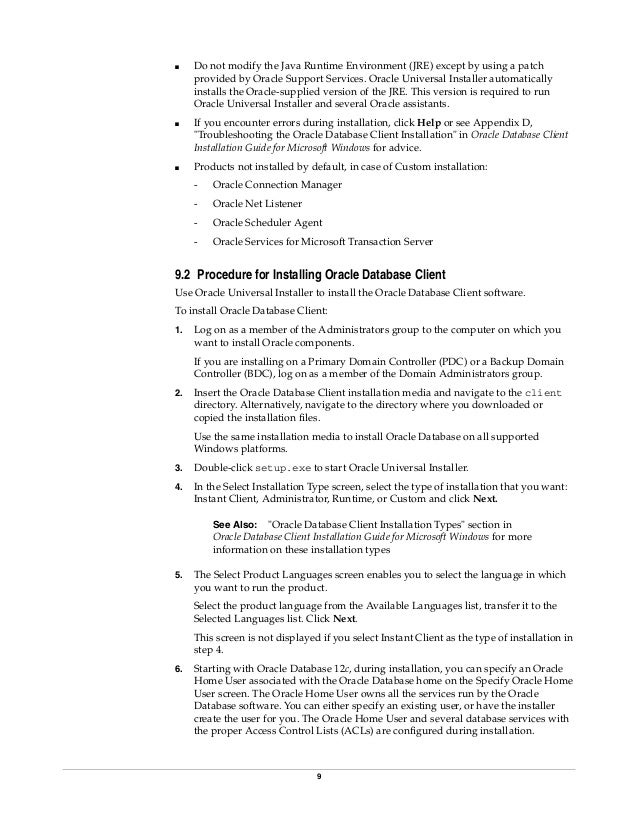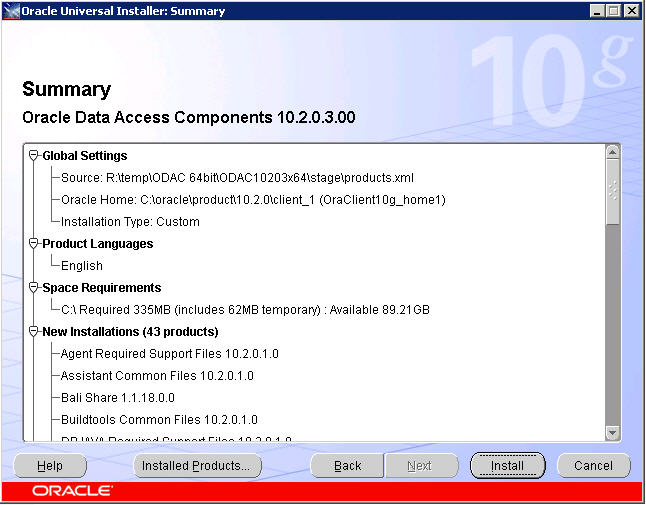Installing Oracle Services For Microsoft Transaction Server
In a distributed database environment, Oracle MTS Recovery Service (automatically installed with Oracle Services for Microsoft Transaction Server) can resolve in-doubt transactions on the computer that started the failed transaction. It can run alongside the unmanaged Oracle Services for MTS version if unmanaged data access drivers, such as ODBC, are also using distributed transactions on the same computer. There are two versions of Oracle.ManagedDataAccessDTC.dll, one for 32-bit.NET Framework and one for 64-bit.NET Framework, installed with ODP.NET, Managed Driver.
- Oracle Services For Microsoft Transaction Server Failed
- Installing Oracle Services For Microsoft Transaction Server 2017
Installation Introduction You can install as part of the Oracle Database Client. OraMTS service will be created for the Oracle Home you installed. Beginning in Oracle 12 c, each Oracle Home has its own OraMTS recovery Windows service. Also, beginning in Oracle 12 c, the OraMTS service runs as the Oracle Home user. Oracle Home User is the owner of Oracle Services that run from Oracle Home and cannot be changed after installation. It can be a Windows built-in account or a Windows User Account.
For enhanced security, Oracle recommends choosing the standard Windows User Account as Oracle Home User for Oracle Database installations rather than a Windows built-in account. The primary purpose of Oracle Home User is to run Windows services with Windows User Account.

However, this user account (Oracle Home User) must be a low-privileged user account that should not be used for database administration. This ensures that Oracle Database services running under Oracle Home User have only the minimal privileges required to run Oracle products. The Windows User Account can be a Local User, a Domain User, or a Managed Services Account. In some cases, such as a software-only install, clone cycles, or an AddNode operation on the database, you may need to manually create the OraMTS service. For more information, see.
Using Oracle Services for MTS with Oracle Data Provider for.NET, Managed Driver Oracle Data Provider for.NET, Managed Driver is a fully managed data provider consisting of 100% native.NET code introduced with Oracle Database 12c. ODP.NET, Managed Driver incorporates Oracle Services for MTS entire enlistment and commit functionality, within Oracle.ManagedDataAccessDTC.dll installed with the managed driver, allowing those functions to execute using managed code.
The Oracle Services for MTS recovery service remains unmanaged. The Oracle.ManagedDataAccessDTC.dll must be deployed with Oracle.ManagedDataAccess.dll for any ODP.NET, Managed Driver applications using distributed transactions. It can run alongside the unmanaged Oracle Services for MTS version if unmanaged data access drivers, such as ODBC, are also using distributed transactions on the same computer. There are two versions of Oracle.ManagedDataAccessDTC.dll, one for 32-bit.NET Framework and one for 64-bit.NET Framework, installed with ODP.NET, Managed Driver. While both versions of Oracle.ManagedDataAccessDTC.dll are fully managed, they must be platform-specific, because the MS DTC application programming interfaces are unmanaged code. Thus, ODP.NET, Managed Driver enlistment and commit functions call either the 32-bit or 64-bit MS DTC, depending on the platform.

Oracle Services For Microsoft Transaction Server Failed
The two versions of Oracle.ManagedDataAccessDTC.dll are located in the following directories:. 32-bit.NET Framework located in: OH odp.net managed x86. 64-bit.NET Framework located in: OH odp.net managed x64 Deploy the Oracle.ManagedDataAccessDTC.dll from the directory appropriate for your.NET application's target platform, 32-bit or 64-bit. Oracle.ManagedDataAccessDTC.dll should not be directly referenced by a.NET application. It will be implicitly loaded by ODP.NET, Managed Driver when using distributed transactions. The Oracle Services for MTS recovery service does not need to run in the same computer as ODP.NET, Managed Driver.
Administrators can specify the host computer name that has a running recovery service in the.NET config file of the application. Manually Creating an Oracle MTS Recovery Service Starting with Oracle Database 12 c, Oracle Database on Windows software includes the oramtsctl.exe utility to enable manual creation of the OraMTS recovery service. Because ODP.NET, Managed Driver does not automatically create the OraMTS recovery service, running this utility creates the service. When run, the service will be created for the current Oracle home and runs as the Oracle Home User.If ODP.NET, Managed Driver can access an existing OraMTS recovery service running on the same computer or another computer, it is not necessary to run this utility.
To manually create an Oracle MTS Recovery Service:. Install an Oracle Database. Open the command prompt. Run this command: oramtsctl -new To delete an Oracle MTS Recovery Service run: oramtsctl -delete Usage oramtsctl -host.port -ip -dtchost -cluster -default -new Create and start a new Oracler1MTSRecoveryService service.delete Oraclehomedirectory Delete Oracler1MTSRecoveryService of current home or specified home.start Start Oracler1MTSRecoveryService service.stop Stop Oracler1MTSRecoveryService service.status Query Oracler1MTSRecoveryService service status.config -port -ip -dtchost -cluster -default Show or set Oracler1MTSRecoveryService service configuration.
Use -default to reset Oracler1MTSRecoveryService configuration.passwd Update Oracler1MTSRecoveryService service user password.trace 0-5 Show traces or set trace level. Set level 0 to turn off tracing.trcdir tracedirectory Show or set trace directory.
Execute operation on host(s) identified by name(s) or IP address(es). Local host is used if option not specified.port Execute -new or -config with this option to specify a service port. Service port is configured automatically if option not specified.ip Execute -new or -config with this option to specify an IP address.default Execute -new or -config with this option to set default configuration. Oramtsctl -new -host host1 host2.domain.com host3 -port 2033 Examples: Install the service with automatic configuration: oramtsctl -new Install the service on port 2032: oramtsctl -new -port 2032 Configure the service to use port 2033: oramtsctl -config -port 2033 Update the service user password: oramtsctl -passwd Install the service on several hosts and use uniform port 2033: oramtsctl -new -host host1 host2.domain.com host3 -port 2033.
1.1 Microsoft Transaction Server Overview Microsoft Transaction Server is a proprietary transaction processing system that runs on an Internet or network server. Microsoft Transaction Server deploys and manages application and database transaction requests on behalf of a client computer. Microsoft Transaction Server provides:. ActiveX/ programming model to develop distributed applications and a runtime environment in which to deploy these applications. properties for components in transactions. Access to performance-enhancing features such as component caching and database connection pooling. Microsoft Transaction Server is a component of the three-tiered, server-centric architecture model.
This model lets you separate the presentation, business logic, and data elements of applications onto different computers connected in a network. Microsoft Transaction Server functionality is also implemented in COM+ and Enterprise Services. Oracle Services for Microsoft Transaction Server, or, support Microsoft Transaction Server, COM+, and Enterprise Services. 1.2 Microsoft Transaction Server and Oracle Integration Overview Without any special integration, you can deploy applications that were created using Win32, Win64, COM, or in a Microsoft Transaction Server that connects to an Oracle Database. To use either of the following features, however, you must install:. Register the Win32, Win64, COM or.NET application as transactional and have Microsoft Transaction Server control the transaction. You can do this by using the Properties dialog box of the component in the Explorer.
Use client-side connection pooling in Microsoft Transaction Server. After you have installed Oracle Services for Microsoft Transaction Server, an is also automatically installed on the same computer. The Oracle MTS Recovery Service helps in the recovery of in-doubt transactions left in Oracle Database instances that originated from this computer. On each connected database:. Create the Microsoft Transaction Server administrator user account. Schedule a database-level transaction recovery job.
This enables the database to participate in Microsoft Transaction Server-started transactions. Create the COM component with any of the following Oracle products:. Access the Oracle Database using any.NET application using. 1.3 Getting Started with Microsoft Transaction Server and Oracle You are now ready to use Microsoft Transaction Server with a database. To get started quickly, follow these steps:. Install the Oracle and Microsoft products required for Microsoft Transaction Server and database integration. Migrate from a previous release of Oracle Services for Microsoft Transaction Server.
Installing Oracle Services For Microsoft Transaction Server 2017
Create the Microsoft Transaction Server administrator user account. Schedule a Microsoft Transaction Server transaction recovery job. See for information about running an application demo that:. Uses transactional components hosted by Microsoft Transaction Server. Accesses a database in a transaction controlled by Microsoft Transaction Server. Create Microsoft Transaction Server-hosted applications. See for instructions on using OCI, OO4O, Oracle ODBC Driver, or Oracle Provider for OLE DB with COM-based applications.
Learn about using Microsoft Transaction Server on the different Windows operating systems. Scripting on this page enhances content navigation, but does not change the content in any way.